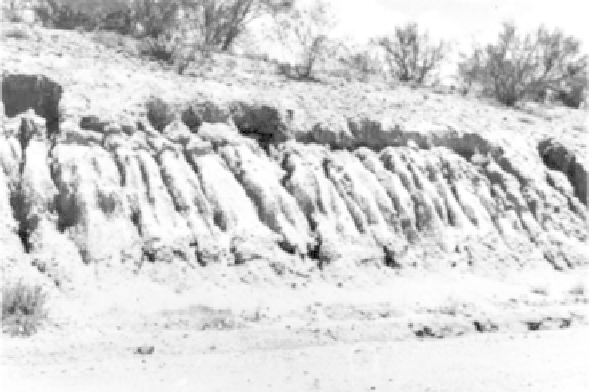Environmental Engineering Reference
In-Depth Information
Dynamic compaction
involves dropping 8- to 10-ton tamping blocks from heights of
30 to 120 ft (9 to 36 m). The drops, made by a crane in carefully regulated patterns, pro-
duce high-energy shock waves that have compacted soils to depths as great as 60 ft (18 m)
(ENR, 1980).
Avoid the Hazard
Settlement-sensitive structures may be supported on deep foundations that extend
beyond the zone of potential collapse or, if the collapsible soils extend to limited depths,
shallow foundations may be established on controlled compacted earth fill after the col-
lapsible soils are excavated.
In Brazil, buildings constructed over collapsible residual soils are normally supported
on piers or piles penetrating to the hard stratum at depths of 3 to 5 m. Floors for large
industrial buildings are often supported on porous clays or small amounts of fill, and pro-
tection against ground wetting is provided. The risk of subsidence is accepted with the
understanding that some relevelling by “mudjacking” may be required in the future.
10.5.5
Piping Soils and Dispersive Clays
General
Soils susceptible to piping erosion and dispersion are not a cause of large-scale subsidence.
Ground collapse can occur, however, when the channels resulting from piping and dis-
persion grow to significant dimensions.
Piping Phenomena
Piping
refers to the erosion of soils caused by groundwater flow when the flow emerges
on a free face and carries particles of soil with it (see
Section 8.3.2).
Occurrence
in natural deposits results from water entering from the surface, flowing
through the soil mass along pervious zones or other openings, finally to exit through the face
of a stream bank or other steep slope as illustrated in Figure 10.35. As the water flows, the
opening increases in size, at times reaching very large dimensions as shown in
Figure 10.36,
FIGURE 10.35
Piping erosion in road cut, Tucson, Arizona. (1972 photo courtesy of Robert S. Woolworth.)



